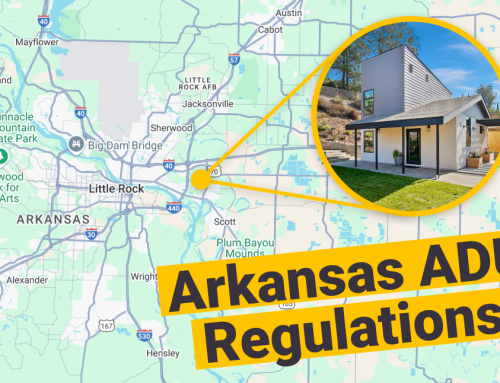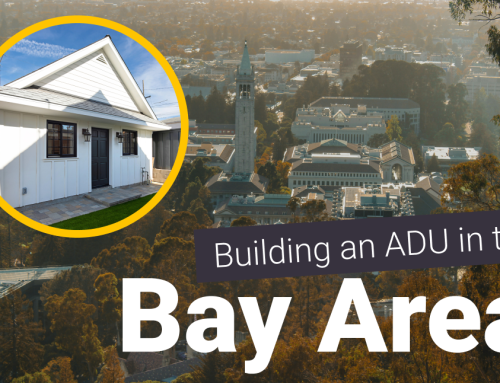Unlocking the potential for affordable and stylish living spaces is more attainable than ever with the rise of Accessory Dwelling Units (ADUs). Still, it’s only natural to want to cut costs where you can when building your new backyard home.
We’ll guide you through the art of balancing affordability and quality, offering practical insights and expert tips to help you maximize your budget without compromising on the charm or functionality of your affordable ADU. From savvy design choices to regulation workarounds, Maxable’s got your back to developing your budget friendly project.
How much does an ADU cost?
The cost for an Accessory Dwelling Unit (ADUs) starts at about $150,000 including design, permitting, and construction. This is for the most simple design ADU with no bells and whistles. For a 500 sq. ft. ADU this comes out to about, $300 per sq. ft.
However, using cost per square foot to estimate what your project will cost can be deceiving. Since these units are smaller, the cost per square foot isn’t offset by extra bedrooms, large living rooms, and hallways you would find in a regular sized home. Plus, different elements like sloping on the lot, level of finishes, and design features, can make a difference between a $300 per sq. ft. project and a $600 per sq. ft. project.
With that in mind, it’s best to use starting costs to estimate the the final cost of your project.
How to Build an Affordable ADU
Sticker shocked? We don’t blame you. But, there are easy ways to save money without sacrificing the quality of your ADU.
Hire a local ADU Designer

Building an affordable ADU starts with being strategic in every phase of the process, starting with design. Designers are a dime a dozen these days, but finding a designer that specializes in ADUs in your area is going to make a world of a difference.
Local ADU designers with a couple of projects under their belt possess a nuanced understanding of zoning regulations, permitting processes, and construction costs specific to your area. Why would this matter in building an affordable ADU? There may be regulations in place that will help you save costs. For example, did you know that ADUs under 750 sq. ft. are not subject to development and impact fees in California? This can save you $5,000 to $20,000! Plus, if they’re familiar with the permitting process, there is less risk of the planning department returning with revision requests, which can elongate your timeline by months.
They can also offer valuable insights to optimize your budget through smart design, especially for small spaces. For instance, incorporating efficient space planning and utilizing multifunctional layouts can maximize functionality without unnecessary square footage. Additionally, strategic window placement and leveraging natural light sources can reduce the reliance on artificial lighting, contributing to both construction and long-term energy cost savings.
Leverage Existing Structures
A conversion ADU is one of the easiest ways to cut costs on your ADU project. Garages offer an ideal starting point. Utilizing your garage for an ADU not only minimizes the need for new construction but also capitalizes on an already built structure. This approach significantly reduces both material and labor costs, making it a cost-effective option for homeowners looking to add extra living space without breaking the bank.
However, before you get started on a garage conversion, you first need to assess the structural quality of the garage. Your designer will send a structural engineer to determine whether the existing structure can be safely converted. If they deem the garage to be too damaged, it will need to demolished, which will actually add costs to your total.
It’s not all bad news though! Even if your entire garage needs to be demolished, the state will still recognize your ADU as a conversion if you stay within the footprint. This means you still benefit from the regulatory advantages.
Utilize Your City’s Pre-Approved Plans

Thanks to AB 1332, all cities in California are required to implement a pre-approved ADU plan program by January 1st, 2025.
Under this program, local designers and architects can submit their own designs to the city. This will create a library of pre-approved ADU designs. Homeowners can then purchase these plans directly from the designer. The intent behind this program is to streamline the permitting process and cut design costs for homeowners while still receiving the support and guidance of the designer.
These designs will cost a fraction of a custom plan from the same designer. One thing to note, however, is that while you are saving in design costs, you need to take construction costs into consideration. Before picking a design, ask the designer how much they estimate the design will cost to build. Even seemingly simple elements like large windows and vaulted ceilings will drive up the cost considerably.
Value Engineering

Value engineering involves analyzing every aspect of the construction project to identify opportunities for cost savings without compromising the quality or functionality of the structure.
One key aspect of value engineering in the context of ADUs is the optimization of material usage. For example, in the kitchen, considering modular cabinetry proves to be a cost-effective strategy. Modular cabinets offer pre-designed and pre-fabricated components that can be easily assembled on-site. This not only reduces labor costs but also minimizes material waste.
When it comes to the bathroom, opting for a prefab shower rather than a fully tiled one presents a practical cost-saving solution. Prefabricated shower units are pre-built and ready for installation, streamlining the construction process and reducing labor hours. These units often come with integrated features, such as shelving and built-in seats, providing functionality while eliminating the need for additional materials and labor associated with custom tiling.
For more info, check out our comprehensive E-course, The ADU Blueprint. Our course includes an exclusive interview with Founder and CEO of GreatBuildz, Paul Dashevsky, where he delves into more value engineering tips and tricks. Get a free preview of The ADU Blueprint here.
With these hacks in mind, you can cut +$50,000 off your ADU’s total cost. Remember, building an ADU doesn’t have to break the bank; it’s about maximizing value and efficiency at every step. With a smart approach to design and construction, your affordable ADU can become a reality, adding value to your property and offering a sustainable living space without compromising on quality.
Build an Affordable ADU Project with Maxable
Unlock substantial savings on your ADU project with Maxable. Our expert team has developed a network of ADU designers and builders dedicated to optimizing your construction journey, providing cost-effective solutions without compromising quality. Start your affordable ADU venture today. Consult with Maxable to get connected to professionals in your area and turn your vision into a reality while maximizing your budget.
Schedule a call with our team today!
FAQ
Is building an ADU worth it?
Yes, building an ADU on your property in California is worth it for a number of reasons.
For starters, adding an ADU to your property can instantly increase its value by up to 35%. Properties with ADUs are quick to be bought when put on the market.
Even if you’re not planning to sell your property, your ADU offers years of flexibility. Whether it’s providing a private space for family members, accommodating guests, or generating rental income, an ADU enhances the overall utility of your property. This property with an ADU for example, nets $5,000 a month!
Can I build an ADU myself to save money, or do I need a general contractor?
Unless you have a background in building large projects like an ADU, it’s best to leave the job to an experienced general contractor. General contractors often have established relationships with subcontractors and suppliers, giving them access to exclusive discounts that can help lower your overall costs.
You also need to take your time into consideration. Building an ADU is a full-time job managing subcontractors, ordering materials, and meeting with inspectors. Unless you have the flexibility to juggle all of these tasks, hiring a general contractor can save you significant time and stress.
Still, if you’d prefer to make your mark on the construction of your ADU, oftentimes we’ve seen clients request for their general contractor to take charge in the foundation and framing while leaving the rest of the finishes to the client. This way, the larger and more complicated parts of the project are taken care of by a professional, while the client can take complete creative freedom on the finishes.
Regardless of what path you choose to take in construction, Maxable can help match you to a vetted ADU general contractor in your area. Just tell us a few details about your project and we’ll start combing through our network to find your perfect match based on your budget, timeline, and property details. Click here to get started.
Is a Prefab ADU more affordable?
No, a prefab ADU will cost approximately the same as a traditional built ADU. You may have seen prefab units advertised for just $75,000 or even lower. But, that figure isn’t including the other costs like transportation, site preparation, foundation pouring, utilities, craning and finishes. Adding everything up, the cost will be on par with the cost of a traditional built ADU.
However, the primary benefit of a prefab ADU is the time saved. A prefab unit can be installed in as little as a week. This is a huge advantage for homeowners that want to avoid months of noisy construction or are looking to start accruing passive rental income as soon as possible.
What financing options are available for ADUs?
Financing options for ADUs include:
- Home Equity Line of Credit (HELOC)
- Home Equity Loan
- Construction Loan
- Home Style Renovation Loan
- Cash-Out Refinance
The best financing option will depend on your credit score, income, and equity. We highly recommend talking to a lender before starting any phase of the ADU process to make sure you qualify for a loan.
Government assistance may also be available to offset some of the costs.








